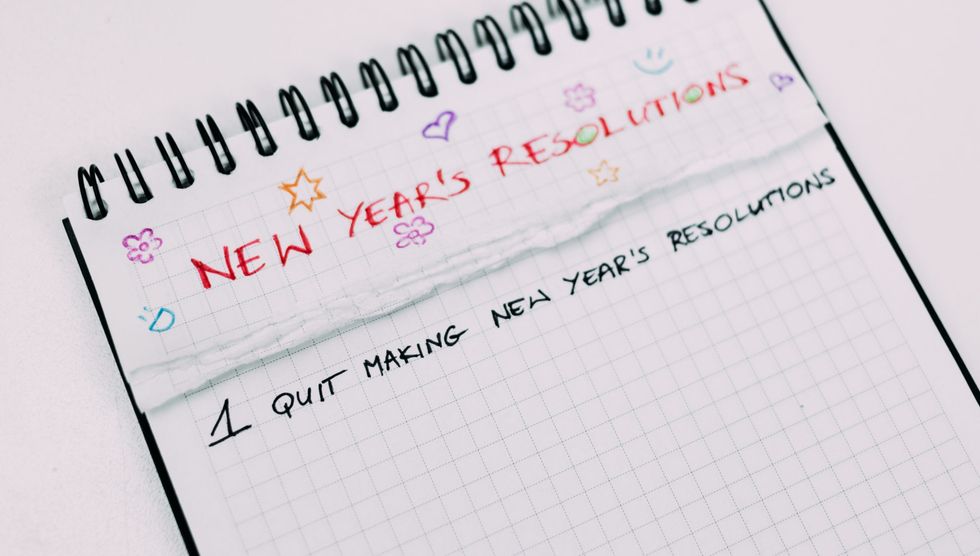One of my family's favorite traditions for the new year is to sit down for a nice lunch on New Year's Day, grab a napkin, and write all of the changes we're going to make in the next 365 days. I used to dread making my own list, since quite frankly I liked myself and thought the idea of committing to major life changes one day a year was ridiculous. It wasn't that I couldn't do them - I lost the weight, I found some inner peace, and I'd chase my goals, but all on my own time and minus the guilt-trip.
If you can relate, you're probably also dreading the constant stream of: "What are your New Year's resolutions?" Or maybe you're not like me and love the idea of a new year and a new start, but aren't the most successful at keeping them. Either way, here's how to reclaim the tradition for yourself and make resolutions you actually have a shot at keeping.
Step 1: Cross off any of the seven deadly resolutions off your mental list.
Wave goodbye to all your previous ideas of what a New Year's resolution should look like.In 2012, Time Magazine released the top 10 most commonly broken resolutions. You could go read them all, but ultimately they break down into the following seven categories:
- "Health" related resolutions (i.e. look better in a bikini, become a Crossfit kween, cut out cheese)
- Bad habit resolutions (stop smoking, all excessive drinking)
- Pursuit of happiness resolutions (be less stressed, feng shui the apartment)
- "Be a better person" resolutions (call your mom more, be nicer to the roomie)
- Carpe diem resolutions (travel outside your means, say “yes” more)
- Self-actualization resolutions (learn something new, become comparable to the karate kid)
- "The money is always greener" resolutions (get 100 percent out of debt, save oodles of moolah)
These are what I like to call the seven deadly resolutions, and just right off the bat, if any of these are on your list cross them off now. The problem isn’t the intention. Everyone wants to be a better person and live more, but the problem is that they’re unrealistic.
You’re setting yourself up for failure by telling yourself that in order to be better you need to completely turn yourself around and become a new human being. What you should be doing is trying new hobbies and fitness programs, not willing yourself to drop a dress size by summer.
Step 2: Look yourself in the mirror and promise yourself that you won’t give yourself unrealistic expectations. Then promise yourself that you’ll stop breaking your promises.
Optional: Sing Michael Jackson's "Man in the Mirror" to your reflection.They say there is power in verbally affirming your intentions. Whether or not that is true is up for debate but what I really want you to do is be forced to look at yourself while saying this so you fully understand that you are making these resolutions for you. Not the ideal version of you and definitely not anyone else. It’s all about getting into the right state of mind. Silly? Yes, but give it a go.
Step 3: Start with what you actually want to do.
Me whenever someone asks me what I like to do during my free time.If college has taught me anything it’s that I (like many people I have cross-referenced with) do best when I care about something. Taking that logic a bit further, if you hate exercising, chances are that making a resolution to take up running will make you miserable no matter how many endorphins your body makes. Remember, this is for you. Jot down three things you love doing and then branch out from there about how you could add on to an existing interest.
Step 4: Make your resolutions SMART.
May your resolutions be as SMART as your car.If you’ve had someone lecture you on goal-making, you’ve probably heard this acronym before since it’s government-sponsored. For those of you who have blessedly made it out of high school without hearing it, SMART = Specific, Measurable, Achievable, Realistic and Timely.
There’s a whole sheet you can download over it, but the gist is that you have to do physical actions toward your specific goals within certain amounts of time. The reason why becoming a “better person” is an unrealistic goal is because you can’t measure “goodness” and therefore fails the SMART test. The reason why pursuing happiness is a bad idea is because happiness is not a permanent state of being and therefore isn’t achievable.
This checking system should help flesh-out your ideas. If you love cinema and you want to go to see foreign films more often, you could find a club dedicated to that hobby or hold an outstanding bi-weekly viewing party with a few good friends with similar interests. Just be sure to actually go and don’t double-book yourself.
Step 5: Create a reminder for yourself but be nice.
Mood boards can double as a fun dorm decoration.
Good reminders: a mood board, a marble counter, a road map to success for yourself.
Bad reminders: offensive “motivational” posters, a reminder on your phone telling you to get off your tush if you want to be successful, having someone yell at you when you mess up.
Resolutions are great and all for looking forward to the new year and reminders help you stay on track to where you want to go in life. That being said, even the most successful resolutions have slip-ups so your reminder should motivate you, not tear you down when things go awry
---
All of that being said, Godspeed for all of you resolution-makers in the new year!








 Photo by
Photo by  Photo by
Photo by  Photo by
Photo by  Photo by
Photo by 















